- [생물학] Making Medical Discoveries: University of Cambridge uses IDL for Morphogenetic Cell Tracking
- [화학] Chemical Engineering: IDL Speeds Reaction Design's Development Path
|
|
|
 |
|
- Customer Challenge
The University of Cambridge researchers needed a data analysis solution that would allow them to dynamically visualize cell movements over time.
- Solution Achieved
A central challenge in developmental biology is the study of how cells reorganize during an embryo's development. Cells reorganize from a mass into an organized structure throughout an embryo's gestation. Each mass of cells follows a set of instructions for which body part it is to become, developing from a sheet-like layer of cells into the recognizable structures that eventually become functioning parts of the body.
IDL has been used for nearly 30 years to analyze and visualize medical images for various purposes - from detecting disease to teaching students about human anatomy. Now, biologists at Cambridge are using IDL to study problems in developmental biology. Advanced imaging techniques and sophisticated data analysis programs like IDL now allow researchers to solve the fundamental mysteries of human development.
Researching biologists, including Richard Adams and Guy Blanchard at the University's Department of Physiology Development and Neuroscience, are particularly interested in understanding the dynamics of these cell movements - or morphogenesis. They hope to understand how these processes proceed in the normal embryo, and how errors can cause some cells to develop abnormally, for instance, those resulting in neural tube defects.
Adams and Blanchard use time lapse imaging to study embryonic cell development of the zebrafish - a popular model that develops rapidly, allowing scientists to study full life cycles over a short period of time. To collect data, zebrafish embryos are placed on confocal microscopes, which are used to obtain high resolution, 3D images of the thick specimens. Embryos are then injected with fluorescent dyes which stain different kinds of cells or regions of cells, making their morphology - or reorganization - easy to track.
Tracking Cell Development Using IDL
To monitor cell behavior over time, Adams and Blanchard used IDL to develop several custom software applications that manage the enormous amounts of confocal data, and to create movies tracking individual cell movement. Adams chose IDL because he says he "wanted a tool that had gave access to the mathematical functions that we needed, and allowed me to perform everyday tasks such as displaying an image without writing lots of code." The lab's custom applications allow the participating biologists to isolate and slice and dice data, pick subsets of that data, reconstruct slices into 3D models, and ultimately generate movies following cell development.
The lab is visited frequently by many collaborators who use Adams' and Blanchard's IDL-based programs, so they are designed to be as user friendly as possible. IDL's widgets and other built-in functionality allow the team to easily create familiar ease-of-use functionality, such as buttons, sliders and icons. Visitors can use the applications to easily manipulate and animate their own data.
Blanchard is currently developing an IDL application that takes the research one step further. It automatically identifies cells in the movies and follows and analyzes their changes over time. "IDL allowed us to incorporate sophisticated algorithms, create routines to easily track cell movements, look at shape changes, and to visualize our data effectively," said Adams. "Before, I had to spend a lot of time writing code to do my job, rather than concentrating on the science.
- Benefits
- The lab's custom applications allow the participating biologists to isolate and slice and dice data, pick subsets of that data, reconstruct slices into 3D models, and ultimately generate
- movies following cell development
- Before IDL they had to spend a lot of time writing code to do their jobs, rather than concentrating on the science
- IDL allows the researchers to easily track cell movements, look at shape changes, and to visualize data effectivley
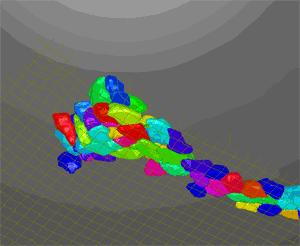
Image shows a three-dimensional reconstruction of cells in the ectoderm of the zebrafish as they begin to form the neural tube
Image courtesy Nora Schultz, Guy Blanchard & Richard Adams, University of Cambridge
|
|
 |
|
- Customer Challenge
Engineers in the chemical processing industry face the dual challenge of making processing more efficient while also allowing for environmentally responsible manufacturing practices. Engineers at Reaction Design needed a way to bridge the gap between laboratory-induced chemical synthesis and real-life chemical reactions in the plant or factory setting with computer software.
- Solution Achieved
With the help of IDL, Reaction Design has created an easy-to-use commercial software simulation product to help engineers study chemical processes and their impact on the environment.
Reaction Design, a company whose business focuses on improving chemical processes using simulation techniques, data visualization, and engineering services, provides software simulation tools that incorporate both chemical reaction and transport models. The company needed to quickly develop a simple, multi-platform user interface that would be broadly accepted across a wide-range of user expertise, save engineers time, and help to differentiate Reaction Design in the marketplace.
The software produced by Reaction Design, Chemical Reaction Data (CHEMKIN), simulates chemical process behavior using sets of chemical reaction rates and physical properties of chemical species. The simulations typically output data files that are 20-100 MB in size.
Reaction Design selected IDL to create the graphical user interface (GUI) and to provide quick visualization for CHEMKIN, a set of software tools for modeling chemical reactors because it was easy to use and had many built in processes and procedures that they could implement in their product.
CHEMKIN includes software applications for the simulation, optimization and design of combustion, chemical processing, microelectronics processing and environmental protection. Designed for scientists involved in either the chemistry or engineering aspects of process designs including gas phase and surface chemistry, CHEMKIN has over 500 users worldwide.
According to Steve Miller, a software strategist for Reaction Design, the Research and Development group has generated 15,000 lines of IDL procedure code to build the GUI and Plotting Package for CHEMKIN. The group distributes a runtime version of the IDL procedures using the embedded license key and the IDL runtime engine. The IDL routines Miller's group uses most are the GUI routines and the line and contour plot objects - including IDLgrPlot and IDLgrContour.
From a timesaving perspective, both Miller and Meeks agreed that compared to writing code using another programming language, IDL saves time.
"We were able to develop an initial user-interface and post-processing capability in just a few person-months for our initial IDL-enhanced product release," stated Meeks. "This is significantly less than what would have been required for development in a lower-level programming language such as C++ or Java, especially if you consider the additional testing required for multiple-platform support and installation procedures," she said.
- Benefits
Providing professional quality post-processing options gave users an easier path to the initial visualization of their results and provided Reaction with a consistent interface to support - much easier than trying to support each user's choice of plotting package IDL allowed the developers to spend virtually no time finding or working around IDL bugs IDL's stability and the behavioral consistency across platforms is a key benefit The project took significantly less time than what would have been required for development in a lower-level programming language such as C++ or Java, especially if one considers the additional testing required for multiple-platform support and installation procedures.
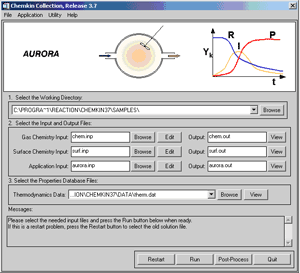
Reaction Design selected IDL to create a graphical user interface (GUI) and to provide quick visualization for CHEMKIN, a set of software tools for modeling chemical reactors.
Images courtesy Reaction Design
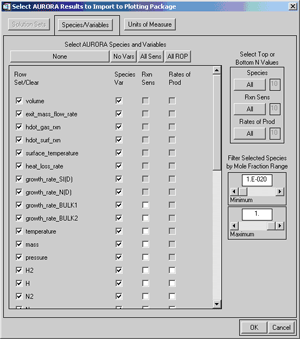
Images courtesy Reaction Design
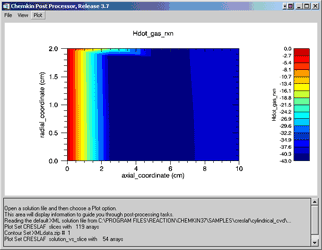
Images courtesy Reaction Design
|
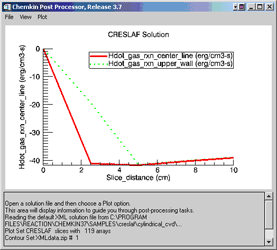
Images courtesy Reaction Design
|
|
|